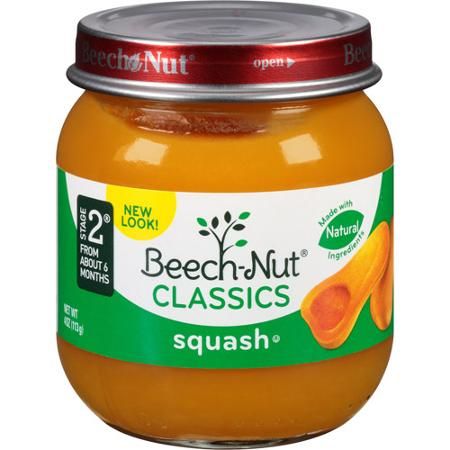How to strain baby food
Fresh and Easy: How to Make Pureed Baby Food
Starting the transition from breast milk or formula to solid foods can be quite daunting for parents.To add to the challenge, there are hundreds of commercial pureed baby food options on the market to choose from. In addition, commercial baby food can be expensive. Homemade pureed baby food is a great alternative since it is typically less expensive and more nutritious than commercial options. In fact, some parents prefer making pureed baby food, so they know exactly what is in the food they are feeding their baby. Making pureed baby food can be easy way to ensure your child is exposed to a wider variety of foods than what is available in commercially made options. In this fact sheet we will walk you through how to safely prepare and store pureed baby food so it is nutritious, convenient, and less expensive than store bought baby food.
Start Simple
Start with one food at a time and select foods that are nutritious and easy to mash such as bananas, avocados, peaches, mangoes, plums, grapes, potatoes and butternut squash. If your baby responds well to these, advance to other nutritious foods such as asparagus, kale, ground chicken, or quinoa. Starting with one food at a time allows your child to adjust to different flavors and allows parents to easily determine if they are allergic to certain foods. Babies are naturally intuitive eaters, meaning they have a very good sense of how much food they need to eat at any given time. Do not encourage babies to eat more or less than they choose to. Look for signs that your child has had enough to eat, such as, turning their head away or spitting out food.
Preparing a Homemade Puree
Preparing pureed baby food may seem like a huge undertaking but it doesn't need to be. Many of the foods you eat with your family can be mashed up for baby to eat with you. Here are some tips on how to safely and easily prepare different foods for your infant:
- Fruits and vegetables: Wash, peel, and remove seeds that may cause choking. If using canned or frozen products be sure to check the ingredient list to avoid excess sugar and salt.

- Meats/fish/poultry: Remove all fat, skin and bones before cooking. Also remove any visibly tough parts. Meats, fish and poultry should be chopped/ground as fine as possible to prevent choking.
- Oatmeal: Grind oats to a fine powder using a food processor or blender and simmer in water. Use breast milk or formula to cook instead of other liquids. This makes the oatmeal even more nutritious for baby.
- Texture is important for babies when they are first eating solid foods. Cook the food until it is very tender, easy to mash, or can be eaten as finger food. Steaming is the best way to retain vitamins and minerals and achieve an appropriate texture.
- When preparing food for the family, remember to remove the baby’s portion before adding salt, sauces and other seasoning.
- Let food cool before feeding your baby.
 The food should be lukewarm (between 80-105° F) when you put it up to your lips.
The food should be lukewarm (between 80-105° F) when you put it up to your lips.
Storing Pureed Baby Food
Properly storing pureed baby food is crucial to your baby’s well-being. Improper storage can result in the growth of harmful bacteria that can cause serious illness. The following storage and food safety recommendations are adapted from the USDA Home-Prepared Infant Food guidelines.
- Prepared pureed baby food should not be held for longer than 2 hours at room temperature.
- Refrigerate foods immediately after preparation. Ensure your refrigerator is consistently at a temperature of 40° F or lower to keep food safe.
- Keep foods in shallow airtight container and always label it with the date. Store for up to 2 days in a refrigerator or 3 to 4 months in a freezer. Meats should be used within 24 hours.
- Freeze in small portions.
 There are two recommended ways:
There are two recommended ways: - Ice Cube Tray Method: Pour pureed food in a clean ice cube tray then cover with plastic wrap or foil until frozen. Once frozen place ice cubes in an airtight container.
- Cookie Sheet Method: Drop 1-2 tablespoons of pureed food onto a cookie sheet then cover with plastic wrap or foil until frozen. Once frozen, place drops of frozen pureed baby food in an airtight container.
- Thawing should be done in the refrigerator, under cold running water, or as part of the reheating processes. Never thaw pureed baby food at room temperature. Thawed portions that don’t get eaten should be thrown away, not refrozen.
Food Safety
While adult and child food safety procedures are the same, being attentive to food safety and sanitation is vital. Proper food safety helps prevent harmful bacteria from entering your infant’s food. Below are USDA recommendations for food safety.
Below are USDA recommendations for food safety.
- Lightly rub the produce under running water before you peel, cut, or puree it. For produce that is more firm such as melons you may want to use a clean vegetable brush. Cleaning produce prevents dirt and bacteria from entering your child’s food. Throw away produce that is moldy or bruised.
- Always have clean utensils, surfaces and hands. You should wash utensils and surfaces after each use. Wash your hands before, during, and after preparing food.
- Bacteria thrive in the mouth, once a spoon touches the mouth and then the food, the food shouldn’t be saved for later use.
- Separate raw meat from all other foods.
- Reaching appropriate temperatures are vital for preventing food borne illnesses. Always ensure any meat or fish is cooked to the proper temperature (Table 1).
 Use a clean food thermometer to check the temperatures of foods.
Use a clean food thermometer to check the temperatures of foods.
Table 1. USDA: Safe Minimal Internal Temperature Chart
| Beef, pork, veal, and lamb - Steak, chops, roasts | 145° F and allow to rest for 3 minutes |
| Ground meats | 160° F |
| Ham, fresh or smoked (uncooked) | 145° F |
| Fully cooked ham | Reheat to 165° F |
| Poultry - Breasts, whole bird, legs, thighs, wings, ground, stuffing | 160° F |
| Eggs | 160° F |
| Fish/Shellfish | 145° F |
| Casseroles | 165° F |
| Leftovers | 165° F |
What to Avoid
There are a handful of food and beverages that are unsafe to feed your baby. The table below explains why your infant shouldn’t consume these products.
The table below explains why your infant shouldn’t consume these products.
Table 2: Foods and Drinks that Should Be Avoided by Infants until 1 Year Olds
| Food to Avoid | Reason | Explanation |
|---|---|---|
| Rice drinks | High arsenic levels Malnutrition | High arsenic levels can lead to decreased performance and developmental delays. Lack of calories, protein and fat in rice drinks can lead to malnutrition. An example of a rice drink would be rice milk or Horchata. |
| Honey | Botulism | Risk of clostridium bacterial spores which can cause infant botulism.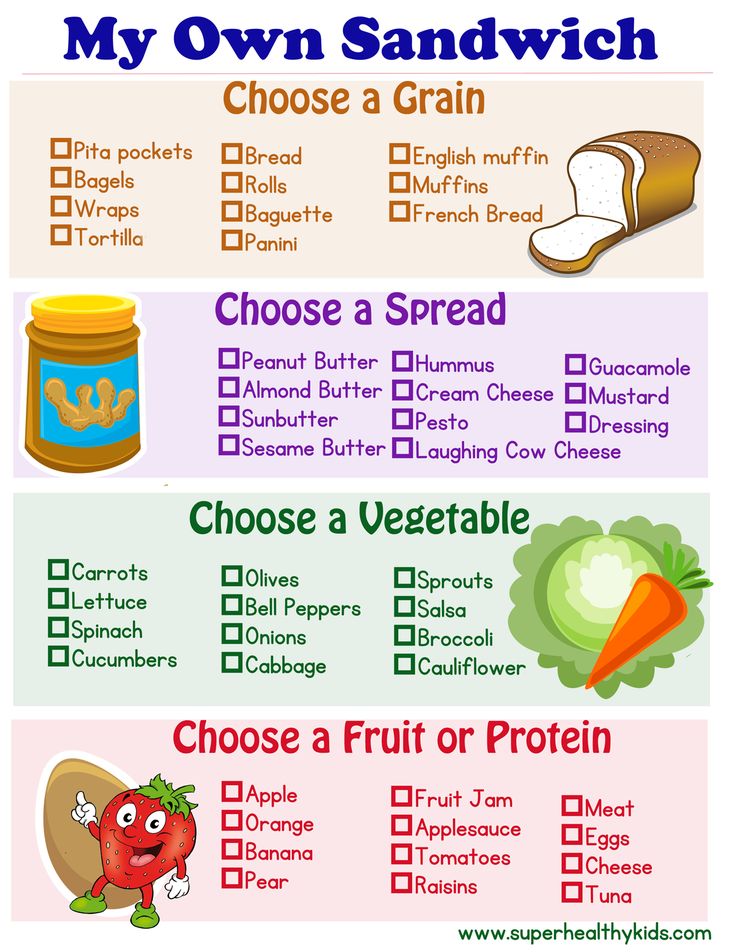 |
| Cow, goat, and soy milk | Iron deficiency anemia | Risk of iron deficiency anemia and deficiency of other important nutrients found in breast milk and formula. |
| Water | Malnutrition | Water should not be used to replace breast milk or formula as it can result in malnutrition. Water is acceptable for infants when mixed in food or in small amounts for drinking in extremely hot weather. |
| Home canned foods | Botulism | Can be a botulism risk if not canned/processed correctly. |
Nutrient Comparison for Commercial Pureed Baby Food and Homemade Pureed Baby Food
Commercial and homemade purees each have their own strengths and drawbacks in regards to safety and nutrition. For example, commercial puree has been found to have more calories and vegetables per serving as compared to homemade. However, homemade purees typically have more protein per serving. Commercial baby food has been found to be a healthy, convenient option if chosen wisely. Combination commercial pureed baby foods (commercial baby foods that contain more than 1 food item) can be higher in starch, salt, and sugar. The American Academy of Pediatric Nutrition Handbook states that “food choices should be encouraged, whether home or commercial prepared, are those with no added salt or sugar”. Early exposure to sodium and sugar can set taste preferences for the child’s future. Be sure to check food labels of commercial baby food for lower amounts of salt, sugar, and higher amounts of protein.
For example, commercial puree has been found to have more calories and vegetables per serving as compared to homemade. However, homemade purees typically have more protein per serving. Commercial baby food has been found to be a healthy, convenient option if chosen wisely. Combination commercial pureed baby foods (commercial baby foods that contain more than 1 food item) can be higher in starch, salt, and sugar. The American Academy of Pediatric Nutrition Handbook states that “food choices should be encouraged, whether home or commercial prepared, are those with no added salt or sugar”. Early exposure to sodium and sugar can set taste preferences for the child’s future. Be sure to check food labels of commercial baby food for lower amounts of salt, sugar, and higher amounts of protein.
Cost Savings
Commercial purees aren’t always the most cost effective options. The table below compares the prices of a single package of commercial name brand baby food and the amount of fruit or vegetable found on the top of the package to homemade.
Table 3: Price Difference in Commercial Pureed and Homemade Pureed Baby Food
| Commercial | Fruit/Vegetable per package | Price | Fresh | Homemade price |
|---|---|---|---|---|
| Apple package | 1/3 apple | $0.74 | Fuji Apple | $0.42 |
| Banana package | 2/3 banana | $0.49 | Banana | $0.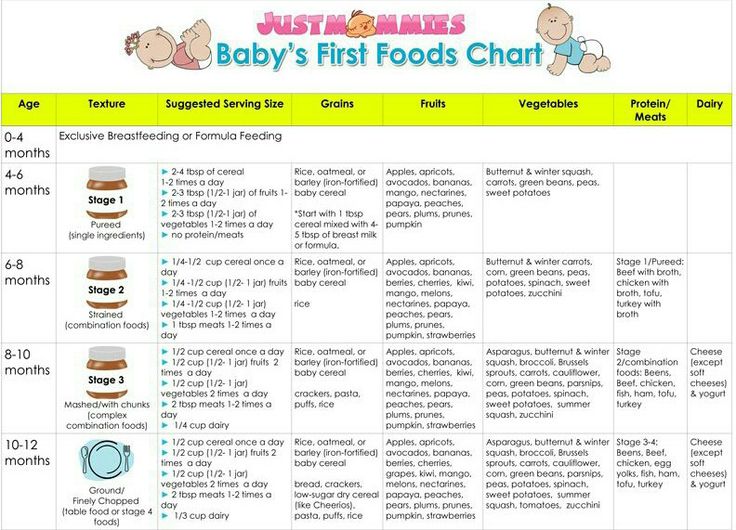 36 36 |
| Pear package | 1/3 pear | $0.49 | Concorde Pear | $0.49 |
| Mango, pouch | 1/4 mango | $1.24 | Mango | $0.25 |
| Prunes package | 2 3/4 mango | $0.49 | Prune | $0.20 |
| Carrots package | 1 large carrot | $0. 74 74 | Carrot | $0.20 |
| Green beans package | 14 green beans | $0.49 | Green Beans | $0.21 |
| Sweet Potato package | 1/2 potato | $0.44 | Sweet Potato | $0.15 |
| Pea package | 60 peas | $0.49 | Peas | $0. 29 29 |
| Butternut Squash package | 1/4 cup cooked squash | $0.74 | Butternut Squash | $0.16 |
*Amount of fruit or vegetable per package was considered when calculating homemade price. Prices found at Walmart Online, April 11, 2018.
Give homemade pureed baby food a try! Having the hands-on experience of making your child’s puree will allow you to have confidence that your child in being fed nutritious and delicious foods. Why go to the store and buy a butternut squash puree when you’re already making a butternut squash for dinner? Mash it up, check the temperature, and you’re ready to go.
References
- American Academy of Pediatrics (2015). Working Together: Breastfeeding and Solid Foods.
 Retrieved from https://www.healthychildren.org/English/agesstages/baby/breastfeeding/Pages/Working-TogetherBreastfeeding-and-Solid-Foods.aspx
Retrieved from https://www.healthychildren.org/English/agesstages/baby/breastfeeding/Pages/Working-TogetherBreastfeeding-and-Solid-Foods.aspx - California Department of Public Health (2010). Welcome to the infant botulism treatment and prevention program. Retrieved from http://www.infantbotulism.org/general/faq.php
- Carenco, J (2013). Bebe Gourment: 100 French-inspired baby food recipes for raising an adventurous eater. New York, NY: The Experiment.
- Carstairs, S. A., Craig, L. C., Marais, D., Bora, O. E., & Kiezebrink, K. (2016). A comparison of pre-prepared commercial infant feeding meals with home-cooked recipes. Archives of Disease in Childhood, 101(11), 1037- 1042. doi:10.1136/archdischild-2015-310098
- Center for Disease Control (2017) Prevention | Botulism Retrieved from https://www.cdc.
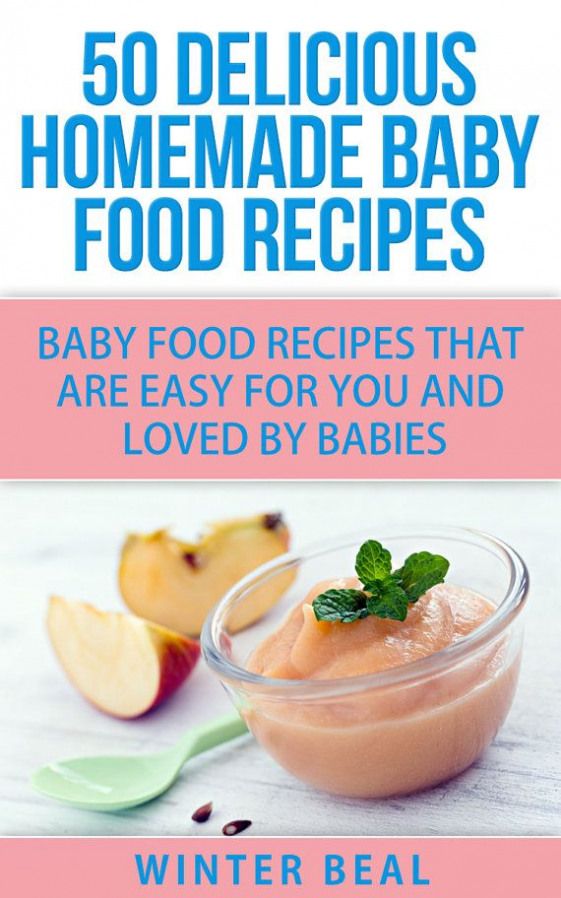 gov/botulism/prevention.html
gov/botulism/prevention.html - Cogswell ME, Gunn JP, Yuan K, Park S, Merritt R. (2015). Sodium and Sugar in Complementary Infant and Toddler Foods Sold in the United States. Pediatrics. February 2015. doi:10.1542/peds.2014-3251
- . L., Yeung, D. L., (2012). Microbial safety, nutritive value, and residual pesticide levels are comparable among commercial, laboratory and homemade baby food samples – A pilot study. The Open Nutrition Journal, 6(1), 89–96. doi.org/10.2174/1874288201206010089
- Garcia, A., Raza S., Parrett, A., & Wright, C. (2013) Nutritional content of infant commercial weaning foods in the UK. Archives of Disease in Childhood, 98(10), 793-797.
- Griebler, U., Bruckmüller, M. U., Kien, C., Dieminger, B., Meidlinger, B., Seper, K., … Gartlehner, G. (2016). Health effects of cow’s milk consumption in infants up to 3 years of age: a systematic review and meta-analysis.
 Public Health Nutrition, 19(2), 293–307. doi.org/10.1017/S1368980015001354
Public Health Nutrition, 19(2), 293–307. doi.org/10.1017/S1368980015001354 - Hopsack, I., Braegger, C., Bronsky, J., Campoy, C., Colomb, V., Decsi, T., … ESPGHAN Committee on Nutrition. (2015). Arsenic in rice: A cause for concern. Journal of Pediatric Gastroenterology and Nutrition, 60(1), 142. doi.org/10.1097/MPG.0000000000000502
- Koluman, A., Gölcü, B. M., Deri̇n, O., Özkök, S., & Anniballi, F. (2013). Clostridium botulinum in honey: prevalence and antibiotic susceptibility of isolated strains. Turkish Journal of Veterinary & Animal Sciences, 37(6), 706–711. doi.org/10.3906/vet-1209-40
- Lockyer, S. (2016). Commercial vs. home-made baby foods - how do they match up nutritionally? Nutrition Bulletin, 41(4), 339-343. doi:10.1111/nbu.12236
- Mok, E., Vanstone, C. A., Gallo, S., Li, P., Constantin, E.
 , & Weiler, H. A. (2017). Diet diversity, growth and adiposity in healthy breastfed infants fed homemade complementary foods. International Journal of Obesity, 41(5), 776-782. doi:10.1038/ijo.2017.37
, & Weiler, H. A. (2017). Diet diversity, growth and adiposity in healthy breastfed infants fed homemade complementary foods. International Journal of Obesity, 41(5), 776-782. doi:10.1038/ijo.2017.37 - Maalouf, J., Cogswell, M. E., Bates, M., Yuan, K., Scanlon, K. S., Pehrsson, P., … Merritt, R. K. (2017). Sodium, sugar, and fat content of complementary infant and toddler foods sold in the United States, 2015. The American Journal of Clinical Nutrition, 105(6), 1443–1452. doi.org/10.3945/ajcn.116.142653
- Randhawa, S., Kakuda, Y., Wong, C. L., Yeung, D. L., (2012). Microbial safety, nutritive value, and residual pesticide levels are comparable among commercial, laboratory and homemade baby food samples – A pilot study. The Open Nutrition Journal, 6(1), 89–96. doi.org/10.2174/1874288201206010089
- Satter, E. (1987). How to get your kid to eat…but not too much.
 Boulder CO: Bull Publishing Company.
Boulder CO: Bull Publishing Company. - Satter, E. (2000) Child of mine: feeding with love and good sense. Boulder Co: Bull Publishing Company.
- United States Department of Agriculture (2017). Infant Nutrition and Feeding. Retrieved from https://wicworks.fns.usda.gov/infants https://wicworks.fns.usda.gov/wicworks/Topics/FG/Chapter 5_ComplementaryFoods.pdf
- United States Department of Agriculture (2015). Safe minimum internal temperature chart. Retrieved from https://www.fsis.usda.gov/wps/portal/fsis/topics/food-safetyeducation/get-answers/food-safety-fact-sheets/safe-foodhandling/safe-minimum-internal-temperature-chart/ct_index
Shayla Shearer Dietetics Student; Mateja R. Savoie-Roskos PhD, MPH, RD; Carrie Durward PhD, RD;
Mateja Savoie-Roskos
Associate Professor
Phone: (435) 797-5777
Email: Mateja. [email protected]
[email protected]
Carrie Durward
Nutrition Specialist
NDFS Dept
Phone: (435) 797-5843
Email: [email protected]
Office Location: NFS 113 / USU Campus
Related Nutrition Articles
Almond Whole Wheat Toaster Waffles
I love this recipe because ithas a great nutty flavor and crisp, light texture. Itreally sticks with me!The whole-wheat flour meansI am getting plenty of fiber and phytochemicals. The almond flour adds a wonderful nutty flavor, and some healthy fats, prot
Apple Cinnamon French Toast
This fruity take on a breakfast classic is ideal for Sunday morning breakfasts with the family or a weeknight breakfast for dinner. Try using a thick sourdough or whole grain bread that will absorb the egg mixture extra well. To mix it up, try different to
To mix it up, try different to
Making Your Own Baby Food
You don’t have to buy commercially prepared food for your baby. Homemade baby food is easy to make, inexpensive and environmentally friendly. It can be as nutritious, if not more nutritious, than store-bought baby food. Eating homemade baby food teaches your baby to enjoy the same foods that you prepare for the rest of the family, also.
Your baby is ready for table food when they can move their tongue from side to side, chew with their new teeth, and spoon feed themselves with their fingers or with your help. When your baby is between six and 11 months old, you can start gradually adding a variety of table foods to their diet. Refer to HGIC 4100, Feeding Your Infant for a general guideline of suggested times to offer different foods to your infant.
At first, feed your baby single ingredient foods that have been pureed. Offer only one new food at a time for several days in a row. Watch for signs of a food allergy (e.g. rash; hives; coughing; diarrhea or vomiting), and contact the doctor if your baby has any of these signs. Otherwise, give your baby about a week to adjust to a new food before offering another one.
Watch for signs of a food allergy (e.g. rash; hives; coughing; diarrhea or vomiting), and contact the doctor if your baby has any of these signs. Otherwise, give your baby about a week to adjust to a new food before offering another one.
Gradually your baby will be ready for some foods that are not pureed. You can begin mashing their foods with a fork or finely chopping soft foods like vegetables, fruits or cooked chicken. You can feed them small cubes of toast or bread, also.
Do not serve your baby a mixed-ingredient food until they have eaten each individual food separately, and you know they are not allergic to any of them. Mixed foods (e.g. casseroles and pizza) are not appropriate for babies under a year old. These foods may cause an allergic reaction, or they may contain ingredients that could choke your baby.
Pureeing Table Food
Definition: Pureeing food means that you put it through a sieve or grinder to make it into a liquid-like, smooth texture. For a thinner consistency, add water or other liquids.
For a thinner consistency, add water or other liquids.
Equipment: You can puree many foods from the family table for your baby by using a fork, potato masher, blender, strainer, food mill or baby food grinder. Foods can be mashed with a fork or chopped finely for older babies.
Safe Preparation Procedures: Follow clean, sanitary procedures in all food preparation and storage. Wash your hands, all surfaces and equipment with detergent in hot water and rinse thoroughly. Use separate utensils and cutting boards for animal foods (e.g. meat and poultry) and non-animal foods (e.g. vegetables, fruits and breads).
After cleaning food preparation surfaces, sanitize them by flooding the surfaces with bleach solution made from 1 teaspoon unscented chlorine bleach to 1 quart water. Allow solution to stand for several minutes, then rinse and air dry or pat dry with fresh paper towels.
Thoroughly rinse fresh fruits and vegetables under running tap water, including those with skins and rinds that are not eaten. While rinsing firm-skin fruits and vegetables, scrub them by rubbing with your hands or with a clean vegetable brush. Remove and throw away bruised or damaged areas where bacteria can thrive on produce. Washing fruits and vegetables with soap, detergent, chlorine bleach solution, or commercial produce wash is not recommended, because they could be absorbed into the produce or leave a residue that could make some babies sick.
While rinsing firm-skin fruits and vegetables, scrub them by rubbing with your hands or with a clean vegetable brush. Remove and throw away bruised or damaged areas where bacteria can thrive on produce. Washing fruits and vegetables with soap, detergent, chlorine bleach solution, or commercial produce wash is not recommended, because they could be absorbed into the produce or leave a residue that could make some babies sick.
Ways to Cook: Steaming and boiling are the best cooking methods to conserve nutrients. Microwave cooking is acceptable, especially for vegetables. Do not add salt, seasonings, sugar, margarine, butter, lard, oil, cream, syrups, gravy, sauces or fat drippings to food for babies less than one year old. Foods taste differently to your baby than they taste to you.
Rub a small amount of pureed food between your fingers to test for smoothness. You may need to add some fluid (e.g. formula, breast milk, fruit juice, water or cooking water) to make it the right consistency.
Foods to Use: Choose high-quality fresh (preferred), frozen or canned vegetables, fruits and meats. The United States now requires Country of Origin Labeling (COOL) to give consumers information about the origin of foods. The following foods sold in retail stores must have a COOL label: meat, poultry, wild and farm-raised fish and shellfish; fresh and frozen fruits and vegetables; peanuts, pecans and macadamia nuts, and ginseng sold by designated retailers. However, these foods are not required to have a COOL label if they have been physically or chemically changed through a process such as cooking, curing or smoking.
Vegetables & Fruits: Wash vegetables and fruits well in clean cold running water. Before cooking, remove parts not to be eaten (inedible peels, seeds, pits). Edible skins and peels can be removed either before or after cooking.
Fresh-cooked vegetables and fruits can be pureed with no added salt, sugar, fat or other unnecessary additives. To minimize vitamin loss, boil fresh vegetables or fruits in a covered saucepan with a small amount of water. Or, steam them until just tender enough to either puree, mash or eat as a finger food.
To minimize vitamin loss, boil fresh vegetables or fruits in a covered saucepan with a small amount of water. Or, steam them until just tender enough to either puree, mash or eat as a finger food.
Canned or frozen vegetables and fruits may be pureed, also. When using commercially processed canned or frozen items, check the ingredient label to avoid extra sugar, salt, fat, and other unnecessary additives.
Commonly Pureed Vegetables & Fruits: Ripe mashed bananas; applesauce; dried, cooked prunes; fresh pears and peaches, soft-cooked and pureed; potatoes; sweet potatoes; winter squash; peas; asparagus and green or wax beans. Do not serve citrus fruits or juices until the baby is one year old.
High-Nitrate Vegetables to Limit: A baby under six months old should not eat home-prepared high-nitrate vegetables, including: beets; broccoli; cabbage; carrots; celery; collard greens; lettuce; spinach and turnips. It is best to wait until your child is a year old before feeding them these vegetables. Limit to no more than one to two tablespoons per feeding.
Limit to no more than one to two tablespoons per feeding.
Nitrates in these foods can change to nitrites, which bind iron in the blood, making it hard to carry oxygen. This may cause breathing difficulty and may even make the skin turn blue.
Meats: Remove all bones, skin, connective tissue, gristle and fat from meats, poultry and fish before cooking. After cooking, remove tough parts and visible fat.
All meats, poultry and fish should be well cooked to kill harmful bacteria, viruses or parasites. Baking, boiling, broiling, braising, roasting, stewing, poaching and steaming are good cooking methods, but frying is not. Cook food until soft and tender and it reaches a safe temperature, according to a meat thermometer. Refer to HGIC 3580, Cooking Meat Safely for more information.
Cut cooked meat into small pieces or thin slices and puree. Warm meat is easier to blend than cold meat. Do not cook food in an oven at a temperature below 325 °F. Do not heat pureed meats in the microwave, because hot spots in the meat could seriously burn your baby’s mouth and throat.
Do not heat pureed meats in the microwave, because hot spots in the meat could seriously burn your baby’s mouth and throat.
Before you feed your child hot dog wieners, luncheon meats or deli meats, thoroughly reheat these meats until steamy hot. Let them cool before serving. Reheating destroys Listeria, a foodborne bacteria that, if present, could make your infant sick.
Eggs: Buy refrigerated eggs with clean, uncracked shells. Store them in the original carton in the main section of the refrigerator, not on the refrigerator door. Use eggs within three to five weeks after getting them home and putting them in your refrigerator.
Hard cook eggs until the yolks and whites are firm and not runny, and then separate the yolks from the whites. Serve only the yolks to babies less than one year old, because egg whites may cause an allergic reaction. To soften the yolks, mash them with some liquid, such as sterile water or infant formula. Make sure that eggs are not kept at room temperature for more than two hours, including serving time.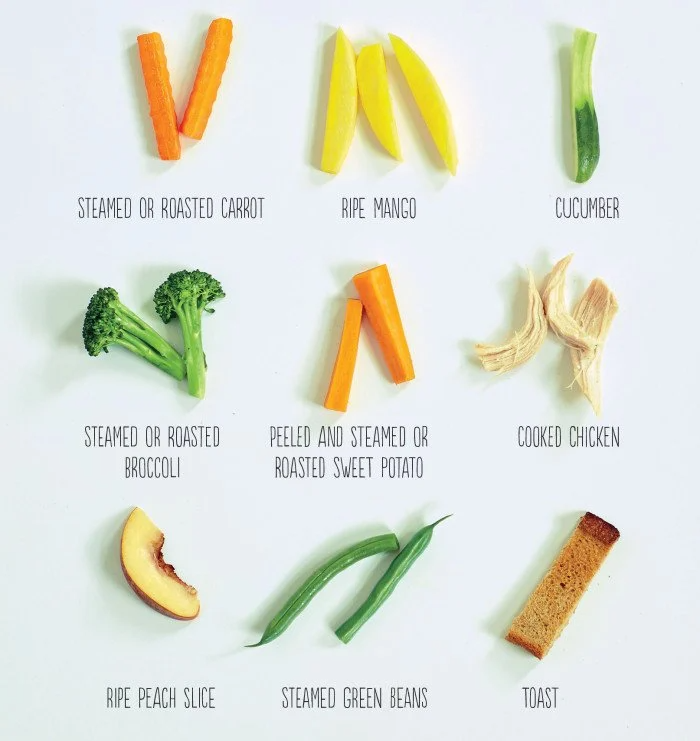
Never feed a baby raw or partially cooked eggs or foods that contain them (e.g. homemade ice cream, mayonnaise or eggnog). Pasteurized egg products, such as dried egg yolks that are used by some chefs and institutions, are extremely safe to serve your baby. However, pasteurized egg products contain some salt or sugar for stability if frozen.
Dry Beans & Dry Peas: Follow cooking instructions on the package label or a basic cookbook. Do not add seasonings, salt, or fat to the beans or peas. Cook until soft enough to puree or mash easily. If canned beans or peas are used, drain the salty water and rinse them with clean water before pureeing or mashing.
Grain Products: Cook noodles, macaroni, spaghetti, rice, barley and other grain kernels until very soft. Then mash, puree, or finely chop, depending on the baby’s development. Babies can choke on cooked grain kernels that are not mashed or ground.
Unsafe Foods to Avoid: Do not give babies any baked goods or other foods that contain honey (e. g. graham crackers made with honey or Honey Nut Cheerios®). Never add honey or corn syrup to your baby’s food, because it may contain bacterial spores that could cause a life-threatening illness or even death. Avoid canned food from dented, rusted, bulging, leaking or unlabeled cans and jars.
g. graham crackers made with honey or Honey Nut Cheerios®). Never add honey or corn syrup to your baby’s food, because it may contain bacterial spores that could cause a life-threatening illness or even death. Avoid canned food from dented, rusted, bulging, leaking or unlabeled cans and jars.
Do not feed your baby any home-canned food except fruits. In addition, do not feed them raw fruit purees, because some raw fruit can carry pathogens and is a food safety risk. Therefore, you should heat the puree of raw fresh fruits (e.g. apples, peaches, pears, melons and other soft fruits) to about 180 °F, or to a simmering temperature, and then cool. The Food and Drug Administration (FDA) also warns against giving young children unpasteurized fruit juices.
Serving Table Food
Prepare foods for a baby immediately before use, and avoid using leftover food. Allow freshly cooked food to cool for 10 to 15 minutes so that it does not burn your baby’s mouth and throat. Before feeding the food to the baby, taste test the temperature using a CLEAN spoon.
Food that is not eaten right away should be refrigerated or frozen immediately after cooking. Cover, wrap, or protect food, and label with the date and time prepared.
Never leave baby food (solid or liquid) for more than two hours at room temperature (between 40 °F and 140 °F) or for more than one hour if the temperature is above 90 °F. Throw out any foods left unrefrigerated for longer times. When food is left out longer, bacteria can grow to harmful levels and may cause your baby to get sick.
Storing Table Food After Cooking
Refrigerator: Baby food spoils more easily than other foods, because it has been pureed or ground. It also does not contain the preservatives needed in many shelf-stable processed foods. If freshly prepared baby food (pureed food) is not used right away, refrigerate it in shallow covered containers and use within one or two days. Meats, poultry, fish and egg yolks should be used within 24 hours. Make sure your refrigerator maintains the food at a consistent temperature of 40 °F or lower to keep food safe.
Freezer: Freeze pureed baby food in single-serve portions so that it can be heated and safely fed to your baby. There are two recommended ways to freeze it.
Ice Cube Tray Method: For single-serve portions, pour cooled, pureed food into a paper cupcake liner or directly into sections of a clean ice cube tray. Cover with plastic wrap or foil and place in freezer.
Cookie Sheet Method: Drop 1-2 tablespoons of cooked, pureed food in separate spots on a clean cookie sheet. Cover with plastic wrap or aluminum foil and put in freezer.
When cubes or pieces of food are frozen solid, put them in a plastic freezer container or bag and store in the freezer. Write the name of the food and the date on the container and use within one month for best quality. Make sure the freezer temperature is cold enough (preferably 0 °F or below) to keep food safe.
Thawing: Frozen food can be thawed, or defrosted, three ways: in the refrigerator; under cold running water or as part of the reheating process.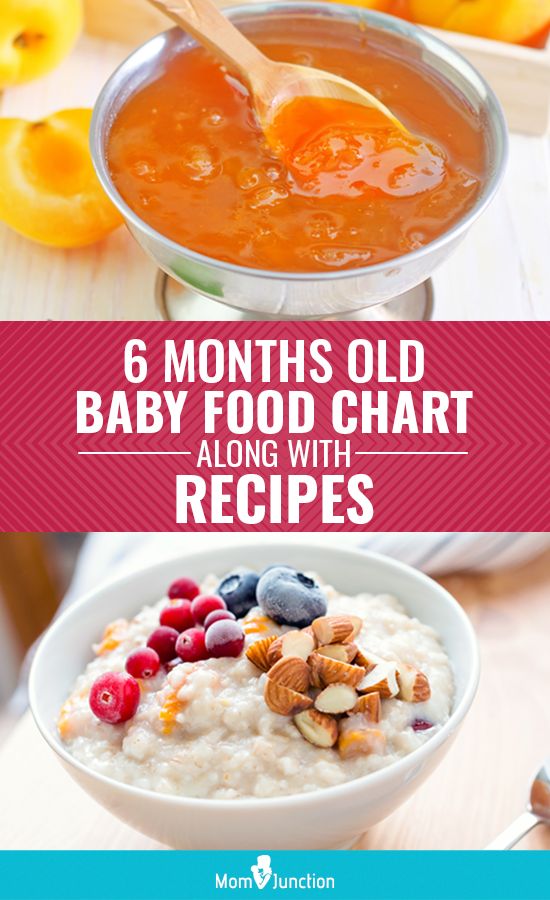 Don’t thaw baby food on the counter at room temperature or in standing water (e.g. in a pan or bowl).
Don’t thaw baby food on the counter at room temperature or in standing water (e.g. in a pan or bowl).
When you remove baby food from the freezer, label it with the date and time removed. Store thawed food in the refrigerator and use most within 48 hours or throw it out. Meats, poultry and fish should be thrown out after 24 hours, however. Do not refreeze baby food that has thawed.
Warming: Baby food can be served cold, at room temperature or slightly warmed. Refrigerated or frozen home-prepared baby food should be thoroughly reheated to at least 165 °F before feeding it to your baby.
There are three ways to warm baby food.
An Electric Baby Dish: This keeps the food at constant temperature, but food should always be stirred and tested for temperature before feeding to the baby.
A Small Heat-resistant Dish Placed in a Saucepan: After dishes are placed in about an inch of water in a saucepan, heat water to simmering, not boiling. When food is warm, remove, stir and test for temperature.
When food is warm, remove, stir and test for temperature.
Higher-fat foods, such as meat and eggs, should always be warmed on the stove, because they heat faster and splatter or overheat more.
A Microwave Oven: Microwave ovens heat unevenly and cause “hot spots,” even if the food feels cool to you. If you decide to heat your baby’s food in the microwave, follow these safety tips. Cover the dish with a microwave-safe cover, not plastic wrap. Stir food well and turn dish often. Heat food only a few seconds to a lukewarm temperature. Stir to prevent “hot spots,” then let sit for a few minutes.
Regardless of the warming method you use, always stir and taste test food yourself. Make sure the temperature is lukewarm and won’t cause severe burns to your baby’s mouth and throat.
Feed your baby with a CLEAN spoon, and throw away any leftover food in the baby’s dish or the serving dish. Reheat food only one time, and never refreeze food that has been thawed.
Pureed Baby Food Recipes
Making your own fresh fruit purees is a food safety risk, unless you heat them first. Raw fruit purees are unsafe for babies to eat, because some raw fruit can carry pathogens. Therefore, you should heat the puree of raw fresh fruits (e.g. apples, peaches, pears, melons and other soft fruits) to about 180 °F, or to a simmering temperature, and then cool. The Food and Drug Administration (FDA) warns against giving young children unpasteurized fruit juices, also.
Bananas Plain & Simple:
Choose a ripe banana with an unbroken peel and no damage to the outside. Rinse the banana under running water and remove the peel. Puree or mash the banana with a clean fork. Serve immediately, and throw away leftover banana.
Applesauce Deluxe:
1 medium apple
4 tablespoons (¼ cup) pineapple juice
Peel, quarter and core apple. Combine with pineapple juice and heat to about 180 °F, or a simmering temperature, until soft. Blend until smooth in texture. Let cool before serving to baby.
Blend until smooth in texture. Let cool before serving to baby.
Apples & Peaches:
1 apple
½ cup + 2 tablespoons water
1 cup peaches (fresh, frozen, or canned in juice)
Peel, core, and dice apple. Combine with ½ cup water in a saucepan, then bring to a boil over high heat. Cook for 5 minutes. Let cool for 10 minutes, then puree mixture until smooth.
While apple is cooling, prepare the peaches. If using fresh peaches, peel and slice them. Combine peaches with 2 tablespoons water in a blender. Puree until smooth. Combine apple and peach mixture and heat the puree to about 180 °F, or to a simmering temperature. Let cool before serving to your baby. Freeze no longer than one month for best quality.
Pureed Fruit Delight:
½ cup freshly cooked or home-canned fruits. Use apples, pears, peaches, nectarines, apricots or cooked dried prunes (without sugar).
2-4 teaspoons liquid (water, formula, breast milk or unsweetened fruit juice – not citrus)
Remove skin and seeds. Press through a sieve, or put ingredients in food mill or blender and puree until smooth. Serve or freeze. Freeze no longer than one month for best quality.
Press through a sieve, or put ingredients in food mill or blender and puree until smooth. Serve or freeze. Freeze no longer than one month for best quality.
Yummy Fresh Fruit:
¾ cup ripe fruit (uncooked peaches, nectarines, pears or apricots) without sugar
1 tablespoon unsweetened fruit juice (not citrus)
Remove skin and seeds. Puree ingredients in baby food mill or blender until smooth. Heat the puree to about 180 °F, or to a simmering temperature. Let cool, then serve or freeze. Freeze no longer than one month for best quality.
Green Peas:
1 cup frozen peas
¾ cup water
Place peas and water in saucepan. Bring to a boil over high heat, and cook for 6 minutes. Let cool 10 minutes, then puree until smooth. Serve or freeze. Freeze no longer than one month for best quality.
Vegetable Medley:
½ cup cooked fresh, frozen or canned vegetables (potatoes, sweet potatoes, green beans, peas, carrots, yellow squash), no salt added
2-4 tablespoons cooking liquid, formula or water
Cook fresh vegetables, or use frozen or canned vegetables without salt or seasoning.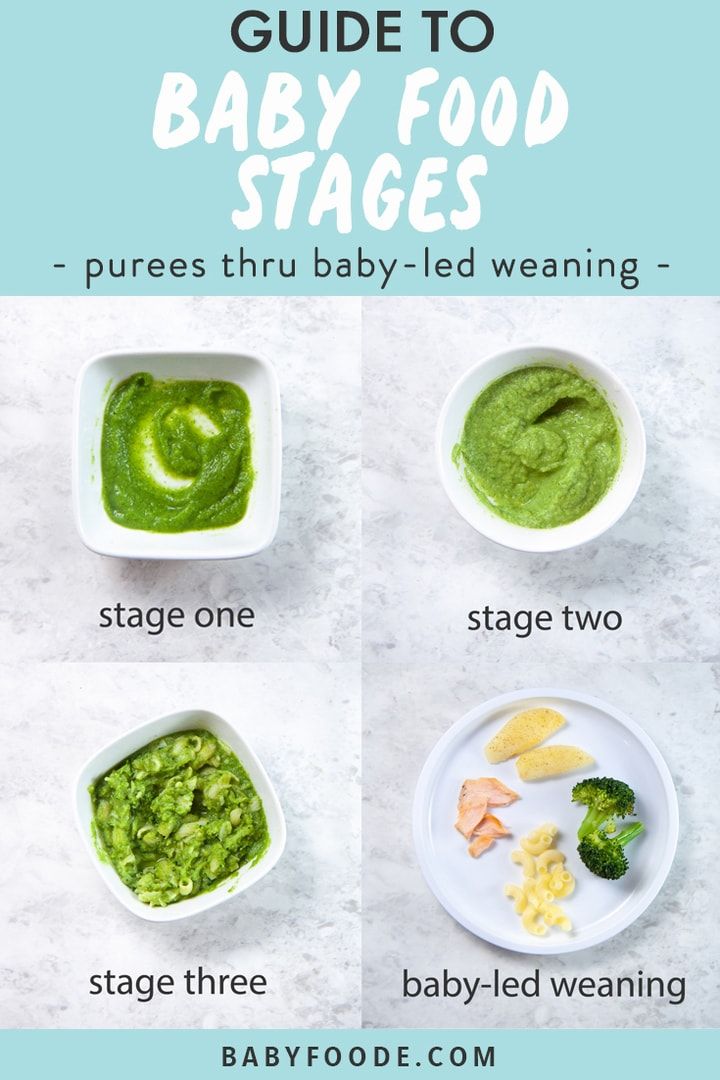 (Read labels for ingredients.) Press vegetable chunks through a sieve or baby food mill. Thin with cooking liquid or formula to eating consistency. Or, put cooked vegetables and liquid in a blender and puree until smooth. Serve or freeze. Freeze no longer than one month for best quality.
(Read labels for ingredients.) Press vegetable chunks through a sieve or baby food mill. Thin with cooking liquid or formula to eating consistency. Or, put cooked vegetables and liquid in a blender and puree until smooth. Serve or freeze. Freeze no longer than one month for best quality.
Note: After the individual vegetables have been fed several times, some good combinations are: potatoes and carrots, potatoes and green beans, carrots and peas.
Simple Strained Meat or Poultry:
(for babies over 8 months)
½ cup cooked meat (small pieces of lean chicken, beef, turkey or pork)
2-4 tablespoons meat broth or formula
Cook lean meat (fat, skin and connective tissue removed) over low heat in a small amount of water. Puree meat and liquid until smooth. Serve or freeze. Freeze no longer than one month for best quality.
Your Choice Combo Dish:
(for babies over 8 months)
1 cup cooked, cubed or diced meat (cut off fat)
½ cup cooked rice, potatoes, noodles or macaroni
⅔ cup cooked, diced vegetables
¾ to 1 cup liquid (formula, broth or water)
Combine and blend until smooth. Serve or freeze in serving-size containers. If frozen, use within one month for best quality.
Serve or freeze in serving-size containers. If frozen, use within one month for best quality.
Note: Serve combination dishes only after you have fed the individual foods several times.
Egg Yolk Puree:
(for babies over 8 months)
Put eggs in a saucepan and cover them with 1 inch of cold water. Put pan on a burner on medium-high heat. Let water come to a boil, put a lid on the pan, and move the pan onto a cold burner. Set a timer for 15 minutes for large-sized eggs (12 minutes for medium-sized or 18 minutes for extra large-sized). When the time is up, cool the eggs promptly by setting the pan in the sink and running cold water into the pan.
Peel eggs and remove yolks. The recommended way to peel an egg is to gently tap the cooled egg on the countertop or table until it has cracks in it. Roll it between your hands until the cracks turn into small crackles all over the egg. Starting at the large end of the egg, use your fingers to peel off the shell.
Combine egg yolks with 1 tablespoon of formula or water per yolk and mash until smooth. Store in refrigerator and use within one day. Or, freeze and use within one month for best quality.
Note: Use only the yolks. The extra egg whites can be used in the family’s casseroles, salads or other dishes. To avoid problems with allergies, wait until your baby is a year old to feed them egg whites.
Fruit & Yogurt:
(for babies 10 months and older)
¼ cup plain yogurt
¼ cup cooked, unsweetened fruit
Combine yogurt and fruit, mashing lumps of fruit if necessary.
Creamy Custard:
(for babies over 1 year)
3 egg yolks
2 tablespoons sugar
2 cups milk, warmed
Mix egg yolks and sugar. Stir in milk and mix well. Cook over low heat, stirring constantly, until mixture coats the spoon. Store in refrigerator and use within one to two days.
Home Canning of Baby Food
Fruits Only: Fruits are the only type of baby food that may be canned safely at home. However, the following fruit purees should not be home canned: bananas; figs; Asian pears; tomatoes; cantaloupe and other melons; papaya; ripe mango or coconut. There are no safe recommendations for these fruits. Other fruits can be pureed or mashed (chunk-style), and then processed in the following way.
However, the following fruit purees should not be home canned: bananas; figs; Asian pears; tomatoes; cantaloupe and other melons; papaya; ripe mango or coconut. There are no safe recommendations for these fruits. Other fruits can be pureed or mashed (chunk-style), and then processed in the following way.
Hot Pack: Select your favorite fruit or mixture of fruits. Stem, wash, drain, peel and remove pits from fruit if necessary. Measure fruit into a large saucepan, crushing slightly if desired. Add 1 cup hot water for each quart of fruit. Cook slowly until fruit is soft, stirring frequently. Press through a sieve or food mill. If desired for flavor, add sugar to taste. Reheat pulp to boil. If sugar was added, boil until it dissolves. Pack hot fruit into clean, hot half-pint or pint jars, leaving ½-inch headspace. Remove air bubbles. Wipe jar rims. Adjust lids. Process half-pints or pints in a boiling water bath for 20 minutes of actual boiling over the tops of the jars. For step-by-step instructions on using the boiling water bath method, refer to HGIC 3040, Canning Foods at Home.
For step-by-step instructions on using the boiling water bath method, refer to HGIC 3040, Canning Foods at Home.
Do not use commercial baby food jars for canning, because they require special equipment for sealing that is not available for home use.
To Serve: Heat the blended foods to boiling, simmer for 10 minutes, cool and serve. Store unused portions in the refrigerator and use within 2 days for best quality.
Caution: Do not attempt to can pureed vegetables, red meats or poultry. Proper processing times for pureed foods have not been determined for home use. Instead, can and store these foods using the standard processing procedures. Then puree or blend them at serving times.
Commercial Baby Foods
Sometimes you want to make baby food at home from fresh ingredients, but at other times you may need to feed your baby store-bought baby food, which is a convenient, nutritious option.
Nutrition Labels: Read nutrition labels so you’ll know what ingredients are in the food you buy for your baby. Most commercial baby food companies no longer add salt, sugar and starch like they did in the past. Combination foods (e.g. dinners and desserts) often have added starch and sugar. They also are more expensive and may be less nutritious than individual foods.
Most commercial baby food companies no longer add salt, sugar and starch like they did in the past. Combination foods (e.g. dinners and desserts) often have added starch and sugar. They also are more expensive and may be less nutritious than individual foods.
Infants grow so fast that they need more calories from fat than older children and adults. Therefore, labels on food for infants and children less than two years old do not list the calories from fat, saturated fat, polyunsaturated fat, monounsaturated fat or cholesterol. Labels also don’t contain the column “Percent Daily Values” or the reference to the 2,000-calorie diet.
Baby food is packaged for different stages (e.g. stage 1, 2 or 3), depending on the texture of the food.
Cautions: Do not feed a baby under one year of age any commercial foods containing whole eggs or egg whites. Never heat commercial baby food in the jars, because they could crack or break when heated in the oven, boiling water or the microwave.
For More Information
For related information on feeding your baby, refer to HGIC 4100, Feeding Your Infant, HGIC 4101, Breast Milk or Infant Formula?, HGIC 4102, Introducing Solid Foods to Infants and HGIC 3640, Food Safety for Pregnant Women & Their Babies.
Originally published 09/05
If this document didn’t answer your questions, please contact HGIC at [email protected] or 1-888-656-9988.
Baby food at home: recipes, video
Growing up a little person is a delightful process that cannot but please the parents of the crumbs. However, the first feeling that mom and dad face when it comes time to introduce complementary foods into a child's diet is confusion.
Which food is the most healthy, hypoallergenic and delicious? Most often, the first "real" meal of the crumbs after mother's milk and formula is vegetable or fruit puree. The choice of baby food on store shelves is very wide - each manufacturer tries to convince the buyer that jars with beautiful labels contain only natural products, there are no dyes, sweeteners and other harmful additives.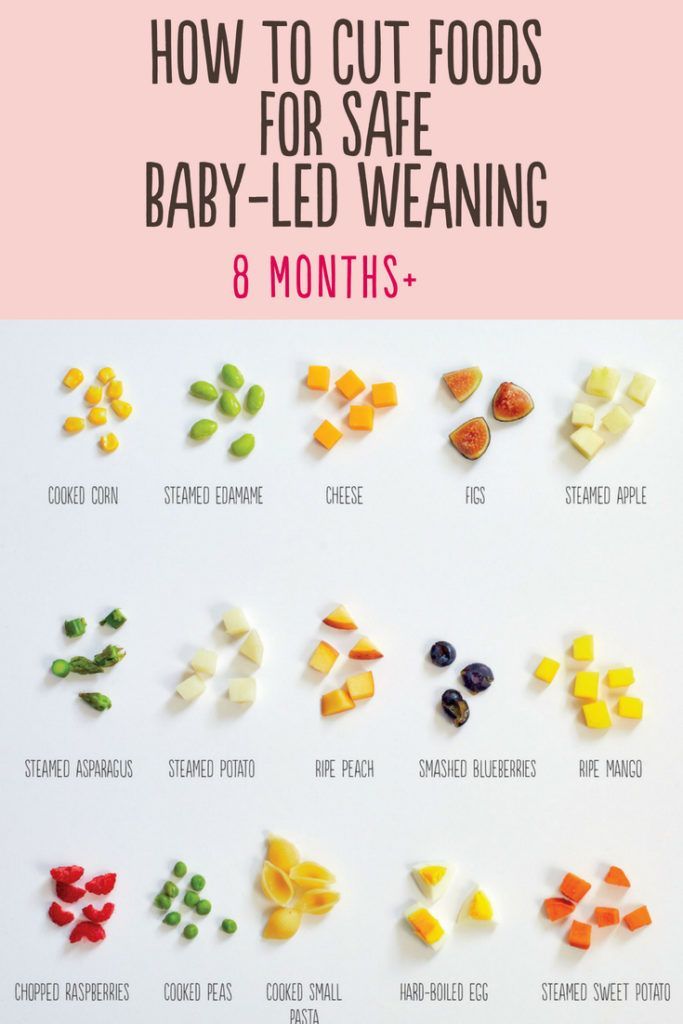 A variety of "meals" for babies in factory packaging marked "3+ months." does not guarantee the true usefulness of the product that is inside. Every mother understands that complementary foods prepared on her own, from natural products, are much better for her child. nine0003
A variety of "meals" for babies in factory packaging marked "3+ months." does not guarantee the true usefulness of the product that is inside. Every mother understands that complementary foods prepared on her own, from natural products, are much better for her child. nine0003
Another advantage of making your own baby food is that you can choose the best ingredients, wash fruits, berries or vegetables thoroughly, peel them well and remove damaged parts. In addition, the parents of the crumbs themselves can choose the way - how best to cook baby food: food can not only be boiled, but also baked in the oven or cooked in a double boiler.
It is also important that home-made baby puree is much tastier, it will undoubtedly be useful for a growing body and will not cause allergies! Even the simplest children's dish, prepared by mom, keeps the warmth of caring hands and cannot be compared with expensive dishes from the store. nine0003
What should be the correct complementary foods for children? Of course, you should start with one ingredient (such purees are called one-component purees), then move on to more complex options. Experts emphasize that the most suitable product for the first "dish" is zucchini. Cauliflower can also be considered neutral. Gradually it will be possible to introduce carrots, pumpkins, potatoes, broccoli and green peas. At the first stage of the introduction of complementary foods, it is better to give preference to vegetable purees and switch to fruit purees when the child already treats “serious” food well. nine0003
Experts emphasize that the most suitable product for the first "dish" is zucchini. Cauliflower can also be considered neutral. Gradually it will be possible to introduce carrots, pumpkins, potatoes, broccoli and green peas. At the first stage of the introduction of complementary foods, it is better to give preference to vegetable purees and switch to fruit purees when the child already treats “serious” food well. nine0003
The basic rules and principles of preparing high-quality baby food yourself:
- it is best to take fresh products for preparations: fruits from the tree, berries from the bush and vegetables from the garden are much healthier than those that have already been in the refrigerator for a week. If there are no seasonal vegetables at the time of preparation, the use of frozen foods is acceptable, but in this case, try to give preference to whole fruits - they retain the greatest amount of nutrients; nine0018
- only filtered water should be used for cooking vegetables;
- the preparation of baby food requires, if not separate dishes, then thoroughly washed.
 Do not, for example, cut vegetables on a meat board. If there is a dog or cat in the house, then you need to restrict her access to the kitchen when food is being prepared;
Do not, for example, cut vegetables on a meat board. If there is a dog or cat in the house, then you need to restrict her access to the kitchen when food is being prepared; - It is not recommended to use vegetables and fruits in the diet of infants, in which the content of chemical additives is consistently high. These often include watermelons and melons, beets, spinach and lettuce; nine0018
- It is better to soak vegetables purchased on the market with water before cooking: put carrots, potatoes, zucchini and cauliflower in filtered water for a couple of hours - this will remove nitrates;
- do not leave excess mashed potatoes for the next meal: the child should be given only freshly prepared food, and "yesterday's" mashed potatoes are best eaten by adults or given to pets;
- you can choose cream, boiled egg yolk, grated cheese or finely chopped dill as an additive to puree - this will diversify dishes for children from 8 months; nine0018
- try it! Children's food can and should be enjoyed by an adult.

There is another question that often worries parents: is it permissible to preserve baby puree and how to do it correctly? After all, such complementary foods for the developing body of a small child must be prepared daily for one or even two or three years: until the baby is ready to eat adult food from the common table. Not every mother has the time and opportunity to prepare baby puree daily, but you don’t want to buy food for the baby in the store. In addition, it is obvious that in the winter-spring period it is almost impossible to find fruits and vegetables grown without the addition of chemicals. The answer to the question is quite simple: the requirements for the conditions for preparing baby food are very strict (keeping the temperature, sterilizing jars, etc.), but using an autoclave solves all problems: all that is required is to load jars with blanks into the autoclave for 20 minutes and set temperature 120 degrees. After cooling, it is better to store baby food in a dark, cool place for about 12 months, daily delighting the child with homemade homemade food. nine0003
nine0003
Pumpkin puree: tender and fragrant
Pumpkin is a tasty vegetable that is good for babies. This fruit has a beneficial effect on digestion, is well absorbed by the child's body and is rich in various vitamins: A, C, B, B2, E, PP, T. In addition, the carotene content in pumpkin is 5 times higher than in carrots!
Baby pumpkin puree has a sweet taste, so the kids eat this dish with great pleasure. For preparations, it is better to buy small whole pumpkins, as they usually taste better than large ones and are easier to peel. nine0003
- Rinse pumpkin well under running water, peel, cut in half, remove seeds.
- Then it is necessary to cut the fruit into small cubes, place in a saucepan and cover with water. Cooking time after boiling - 20 minutes. You can also steam pumpkin: it will retain more nutrients with the same cooking time.
- The next step is to beat the cooked pumpkin with a blender until the consistency of a gentle puree.
 If the dish turned out to be thick, add water or milk (milk mixture). nine0018
If the dish turned out to be thick, add water or milk (milk mixture). nine0018 - Vegetable oil and salt are added to pumpkin puree to taste, but these additives should be used with caution: only if they are acceptable for the age of the child.
For babies older than 8 months, pumpkin puree is supplemented with other fruits and vegetables, and also added to porridge.
Broccoli puree: simplicity and elegance
Broccoli is not just cabbage, but a storehouse of vitamins and microelements! Beautiful on the outside and fantastic on the inside - the high content of protein and vitamin C (there is more in broccoli than in citrus!) deserves special attention. There are many articles on the Internet about the benefits of broccoli, and preparing this product is not at all difficult. nine0003
To prepare this type of cabbage for baby food, you need to choose the highest quality product: the inflorescences must be unopened, green, moderately elastic.
- Broccoli should be washed, cut into pieces and boiled.
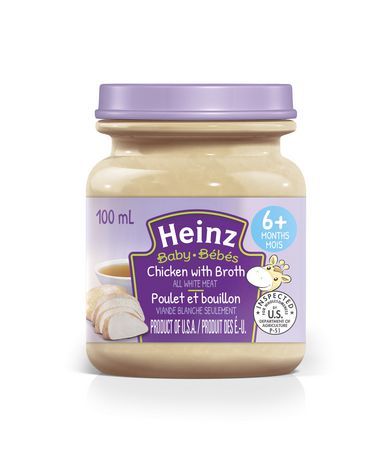 Steaming will take 20 minutes, in water - faster: fresh cabbage should be boiled for a little more than 5 minutes, and frozen - at least 10. When cooking, do not pour a lot of water, it should only cover the vegetables a little.
Steaming will take 20 minutes, in water - faster: fresh cabbage should be boiled for a little more than 5 minutes, and frozen - at least 10. When cooking, do not pour a lot of water, it should only cover the vegetables a little. - When the cabbage is cooked, take it out, transfer it to a blender bowl and grind to a puree state, add a little warm boiled water. nine0018
- Add salt and butter to taste.
Pear puree: a fragrant dessert
It's no secret that babies love fruit puree - almost all children like sweet dishes. The pear is a suitable option for the first one-component fruit food - a sweet fragrant fruit that has a high concentration of vitamins, stimulates digestion and almost never causes allergies.
If you want to cook a safe puree for your child at home, then it is best to choose green pears, these are the fruits that are considered to be the least allergenic. nine0003
- Fruit must be peeled, core removed with seeds, cut into cubes.
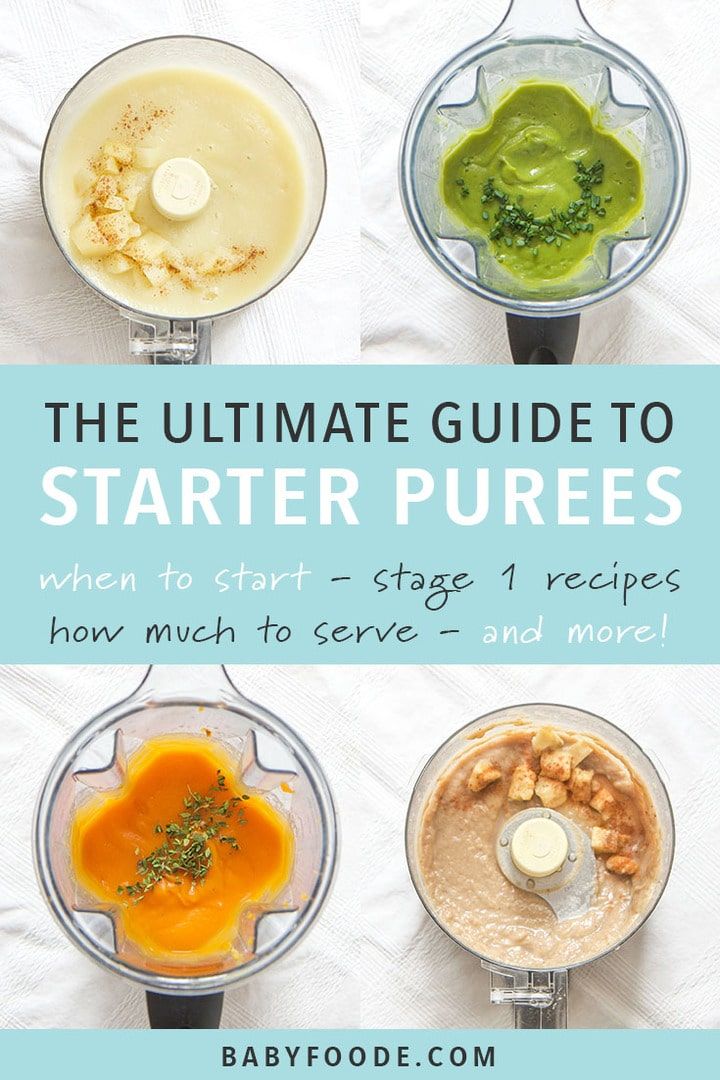
- Transfer the pear to a heavy-bottomed enamel saucepan, add a little water and simmer over low heat for 15-20 minutes.
- Then transfer to a blender bowl and puree until smooth. If the puree is too thick, add a little warm boiled water.
- You can dilute the dish with milk or formula - it depends on the taste preferences of the baby. nine0018
The same recipe is used for applesauce. In the future, try to combine these two fruits in one dish.
Classic apple-zucchini puree
A good appetite of a baby pleases every mother, but little gourmets are often capricious, and it is not easy to please them. Zucchini and apple puree is a classic combination of products that will diversify the baby's menu already in the fifth or sixth month of life.
This complementary food contains only hypoallergenic products, has a positive effect on the functioning of the heart, and stimulates the strengthening of the immune system. nine0003
- Selected products should be thoroughly washed, peeled, core removed from apples.
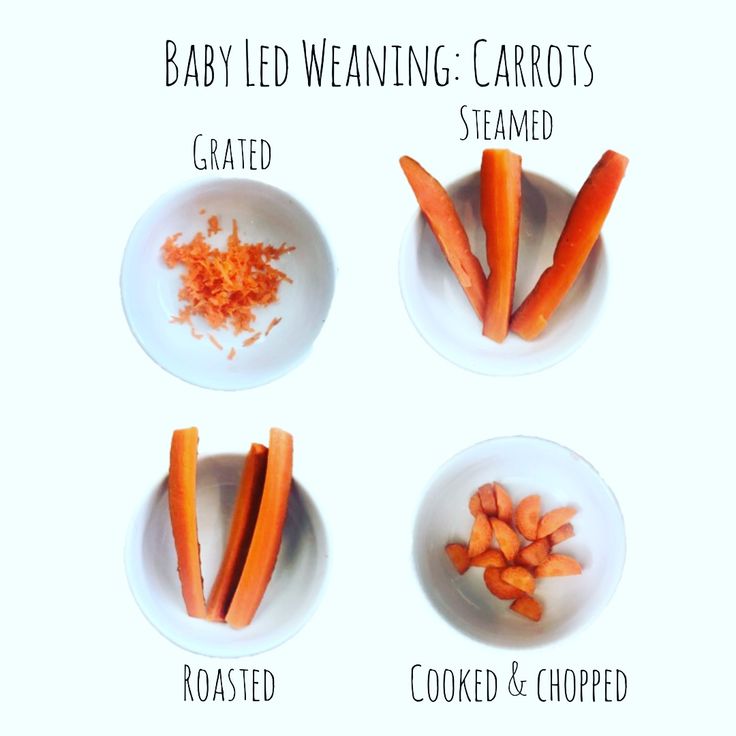
- Cut zucchini and apples into cubes, put fruits in a cooking pot first - they should cook for 5 minutes longer, and then vegetables. The total cooking time is 20 minutes.
- When the food becomes soft, it is necessary to grind it to a puree state using a blender.
- To taste - dilute with water, add salt, oil.
This puree can be considered an independent dish for the little ones or become a delicious side dish for older kids. nine0003
Colorful carrot and potato puree
For many parents, carrots and potatoes are the easiest and most understandable type of complementary food for the baby. However, if you cook and serve standard products a little differently than usual, you can improve the traditional taste of a classic dish.
For baby puree, young potatoes should not be chosen - they contain a lot of starch. Carrots, on the contrary, it is better to buy young ones.
- Wash and peel the vegetables thoroughly and cut into cubes.
 nine0018
nine0018 - It is better to steam the mashed potatoes and carrots, the vegetables should be boiled separately. Cook until tender, 20 minutes on average.
- Separately puree the vegetables in a blender, diluting with warm water if needed.
Both types of puree are beautifully placed on a plate without mixing: the child can decide for himself whether to mix food or eat separately.
Exotic variety: mango puree
Tropical fruits should not be offered to a small child before the age of 7-8 months and only if there was no allergy to other foods.
Mango is an aromatic fruit with an original pleasant taste. This fruit helps to overcome colds, reduce inflammation in the body, improve sleep and normalize the functioning of the stomach.
To feed the baby, ripened fruits should be selected - quite soft, yellow-red in color.
- Fruit should be peeled and pitted, cut into cubes. nine0018
- Put the raw mango into a blender, purée, transfer to a heavy-bottomed pot and boil for a few minutes.

Older children may be offered uncooked mango puree. This fruit is completely independent - no need to add sugar or water!
Sweet pumpkin puree with apple
This puree is called sweet, since both pumpkin and apples are foods with sufficient sugar content. Such a dish is well suited as a dessert for children who already eat “serious” food well - vegetable purees and cereals. nine0003
In addition, such complementary foods are a great option for the autumn-winter period: seasonal products contain enough choline, a lot of fiber, natural proteins and vitamins (groups A, B, C, E, etc.), zinc, sodium, calcium and only!
- Pumpkins and apples must be peeled, peeled and seeds removed, cut into cubes and sent to a double boiler.
- Cook for about 20 minutes until the food is soft. Then place them in a blender bowl, add raisins and chop. If the child chews well, mash everything with a fork, and leave the raisins whole. nine0018
Hearty puree with celery and turkey
For older kids, meat is added to vegetable dishes - turkey fillet is an excellent option for developing a child's taste preferences. Appetizing and fragrant meat puree includes only three ingredients: celery root, turkey fillet, butter.
Appetizing and fragrant meat puree includes only three ingredients: celery root, turkey fillet, butter.
The proportion of meat and celery should be approximately 10:1, the amount of butter to your taste.
- The turkey fillet must be boiled in the "second stock" for about 20 minutes after boiling. nine0018
- Wash, peel and cut the celery root into cubes and put into the boiling broth 10 minutes before it is done.
- After cooking, puree the turkey and celery with a blender, adding stock if necessary.
- Salt to taste and add oil. For one children's serving, 3-5 grams of butter is enough.
A child from early childhood will begin to get used to full-fledged homemade food without the addition of preservatives and harmful components, and will grow up healthy and strong. In summer and autumn, parents can make preparations: prepare potatoes, carrots, beets, pumpkins and apples for storage (these products are stored for a long time - they do not need to be frozen), freeze berries and seasonal fruits, or roll ready-made mashed potatoes into jars! Homemade baby food without unnecessary flavor enhancers and salt is the best complementary food, warmed by mom's love. nine0003
nine0003
baby food, or how I was dieting Reese Witherspoon
Summer is over, but our experiments continue! SPLETNIK.RU editors tests various diets popular among celebrities and reports on results, honestly and without embellishment, to you. This time we talk about the miracle diet Reese Witherspoon based on baby food.
Alice
At the request of the editors, I tested a diet based on baby food, which very popular among Hollywood celebrities. Reese is my example. Witherspoon - it is known that the actress often goes on this diet when she I need to shed a few extra pounds. I note that the appearance of this diet associated with the weight loss method proposed by the famous fitness trainer Tracey Anderson (whose clients at various times included madonna, Gwyneth Paltrow, Jennifer Lopez). nine0003
Reese Witherspoon
The power system is quite rigid, so you can’t stick to it for a long time - maximum two weeks.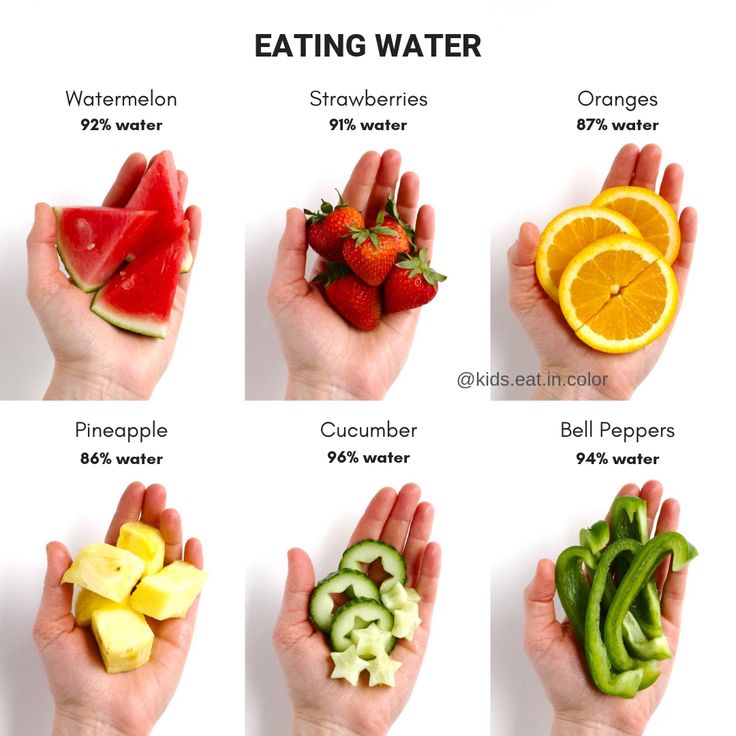 This is a kind of reboot, such a diet is excellent. suitable for those cases when you need to urgently get rid of a couple of three kilograms, and is not at all suitable for long-term weight loss.
This is a kind of reboot, such a diet is excellent. suitable for those cases when you need to urgently get rid of a couple of three kilograms, and is not at all suitable for long-term weight loss.
In principle, I had nothing to compare with: with a height of 162 centimeters and a stable weighing 48 kilograms to my 30s, I have never sat on any diet. I AM I lead a very active lifestyle (extreme sports are my passion), so I have never had any problems with being overweight. Until recently: for Over the winter, I gained five extra pounds and could not get rid of them. My weight stopped at around 53 kilograms, and I decided that I had to act. The experiment from the editorial office turned up just in time. nine0003
The diet began for me not with the selection of certain products, but with the purchase jars with ready-made baby food: vegetable, dairy, meat mixtures, fruit salads and curds. True, I was limited in calories: each my jar was supposed to contain less than 100 kilocalories.
I could eat everything, but I had to keep a careful record of the number of calories. For example, fruit puree without sugar contains only 50 kilocalories per 100 grams of the product, but when adding sugar or cream, the amount kilocalories can increase to 100. My daily ration should not have exceed 1200 kilocalories. nine0003
At first, I was delighted with the chosen power system. First, more A healthy and balanced diet is hard to imagine. No salt, sugar and starch, as well as fried, spicy and smoked foods, plus a complete set of vitamins and minerals. Jars with baby nutrition is very small, portions compared to the usual adults are much smaller. The calorie content of these portions is also low, and everyone strives for this. losing weight.
Secondly, the diet is very convenient: no need to bother with cooking "correct" dishes, everything can be bought ready-made. Assortment of food and drinks wide enough for kids today - my eyes ran wide from diversity. nine0003
nine0003
So my diet was as follows.
Breakfast
9.00 - ready-made cereal porridge plus children's bio-kefir.
Breakfast
Second breakfast
11.00 - fruit curd 3.9% fat.
Second breakfast
Lunch
14.00 - a jar of meat or fish puree, a jar of vegetable puree or ready-made special meat and vegetable puree.
Lunch
Afternoon snack
17.00 - fruit juice and a jar of fruit puree.
Afternoon snack
Dinner
19.00 - a jar of vegetable and meat puree.
Dinner
For the whole day you can eat 6-10 of these jars, and before going to bed - drink a baby drink. kefir. During the day, it is generally advisable to drink as much as possible of the most common clean water, but a couple of times a day you can treat yourself to green tea or baby juice without sugar.
If necessary, you can prepare a fruit smoothie or puree soup on one's own. I trusted the ready-made options and forgot about it for a week. cooking and on the stove. I just bought all the necessary jars of baby food in advance, they made up a full-fledged daily menu.
You can stick to a combined diet option for baby food one to two weeks, after which you need to gradually switch to a normal diet, eliminating all fried and fatty foods from your menu. nine0003
Is this diet worth the sacrifice? Yes! For a week on baby food, it took me 3.5 kilograms! The result surprised me, to be honest.
Before and after the diet
I followed the diet for only one week, and I didn’t dare for the second: I and the first one was hard. Every now and then I wanted to break loose and eat a chocolate bar or to drink coffee. Without the addition of salt and seasonings, all meat and vegetable purees seemed tasteless, in the final it was already just hard to force myself to eat it.





